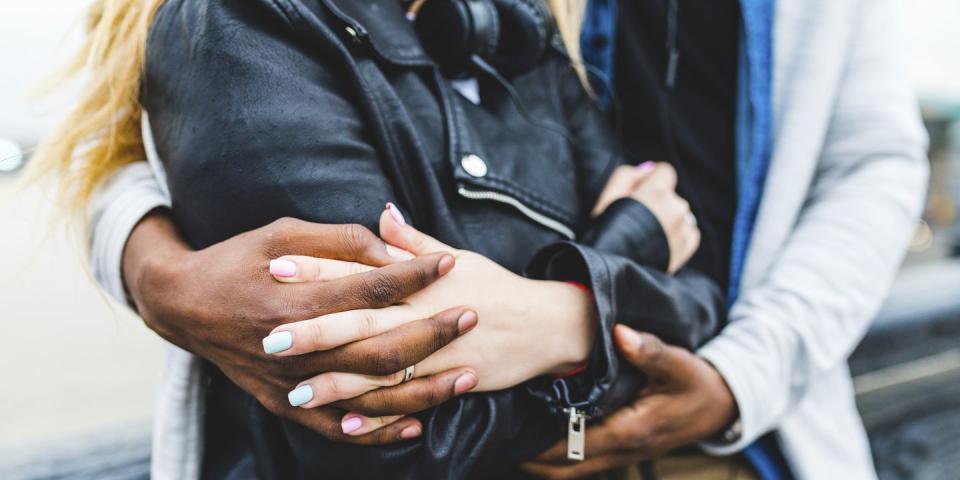Polysexual: What Does It Mean and Is It the Same as Pansexual?

The LGBTQ+ spectrum encompasses a range of sexualities and identities. Some that are commonly known and understood like gay or bisexual, alongside others that a smaller number of people identify with, but are nonetheless important terms that fall under the queer umbrella.
Polysexuality – sometimes represented by a pink, green and blue flag – is one such orientation.
What does polysexual mean?
Polysexuality generally means someone who experiences sexual or romantic attraction to a number of genders, but not all genders.
Of course, other sexualities describe attraction to multiple genders – like bisexuality – but Aoife Drury, a psychosexual and relationship therapist, says people who are polysexual ‘tend to ignore the gender binary [of male and female]’.
But Dr Koen Slootmaeckers from City University, whose research focuses on gender and sexuality politics in Europe, says just because polysexual people are attracted to multiple genders this is ‘not necessarily all genders’ on the spectrum.
The origins of the term polysexual have been attributed to as early as the 1920s, says Dr Slootmaeckers, but other accounts suggest it emerged for the first time in the 1970s. ‘Even if these terms were around in the past, they were not as widespread as now,’ he adds.
What is a polysexual relationship?
Miranda Christophers, sex and relationship psychotherapist, says that polysexuality is ‘usually distinguished by an attraction to three or more gender identities’. But which gender identities those are will vary from person to person and are not set in stone.
It is important to note when talking about polysexuality that this is not the same as polyamory, or being in a polyamorous relationship. Drury says that polyamory is defined as ‘a style of consensual relationships that people have with a few other partners.’
Therefore someone being polysexual and polyamorous does not mean the same thing – they just have the same ‘poly’ root which means ‘many’. So that might mean many partners or many genders depending on the word used.
Is polysexual the same as pansexual?
Polysexuality is not the same as pansexuality either. Yes, pansexual people are also attracted to those across the spectrum of gender, but there is a key difference.
Drury says this comes back to the root of the word: ‘The difference between pansexuality and polysexuality is derived from ‘pan’ meaning ‘involving all' and 'poly' meaning 'many'.’
Dr Slootmaeckers agrees: ‘Whereas pansexual usually refers to people who are attracted to all genders - people of all genders, or some say [they are attracted to people] irrespective from gender - polysexual means that someone is attracted to multiple, but not necessarily all.’
Is polyromantic a thing?
The difference between polyromantic and polysexual is having a romantic attraction to multiple genders – rather than a sexual attraction.
Although polysexual people may well have a romantic and sexual attraction to people of multiple genders, not just sexual. The phrase polysexual, Christopher clarifies as ‘a sexual orientation and not a relationship status or style’.
How do I know if I am polysexual?
Polysexuality does somewhat overlap with other sexualities that describe attraction to multiple genders that are not the binary male and/or female – like pansexuality. But making the distinction between being attracted to all genders and just multiple matters to some people.
In this way polysexuality is a diverse sexuality because it can be ‘entirely about the person’, says Christophers.
She explains: ‘A key to a sexual identity is how someone feels, perceives and understands themselves. With any term around sexual or gender identity, it can mean something different to each individual so it is only by knowing what it means to them that you may truly understand their sexuality.’
It is hard to know how many people are polysexual in the UK, says Dr Koen as we ‘do not collect meaningful data’ on it. ‘It is very hard to know how big these groups are. T
'The more recent censuses [in England, Wales and Northern Ireland this happened in 2021] are asking about sexual orientation (often leaving an open answer option), which would allow us to get somewhat better insight in the prevalence of these sexualities.’
How it feels to be polysexual: ‘In a world with more than two genders, it made sense’
Kevin, a 37-year-old Technical Expert from Melbourne, Australia, first identified as polysexual around three years ago after years identifying publicly as gay.
‘Previously I publicly identified as gay, but personally felt more bisexual. A 5 on the Kinsey scale [a scale 0-6 used to describe orientation] you might say. I now feel the concept of polysexual makes that scale very much redundant though as it encompasses far more than we previously acknowledged.
‘As gender-neutral and gender-fluid individuals started identifying themselves, I realised that polysexual was a better label that matched the way my attraction to individuals worked (being attracted to individuals instead of a specific gender). In a world with more than two genders, it simply made sense.
‘For me, it’s about being attracted to individuals because of who they are and the individual interactions with them. Sure, sometimes there are physical elements that come into it. But it’s beyond gender or orientation and more about acknowledging that I am attracted to the whole individual (their mind, body and soul) as a whole package instead of just a penis or a vagina.
‘[There are some misconceptions] I feel most people just lump it in with bisexuals because it’s easier for them to understand. There is also a fair amount of discrimination from the wider gay community. I’m sometimes told that I should just accept that I’m gay and stop trying to be “woke”.’
You Might Also Like

 Yahoo Sport
Yahoo Sport 





































